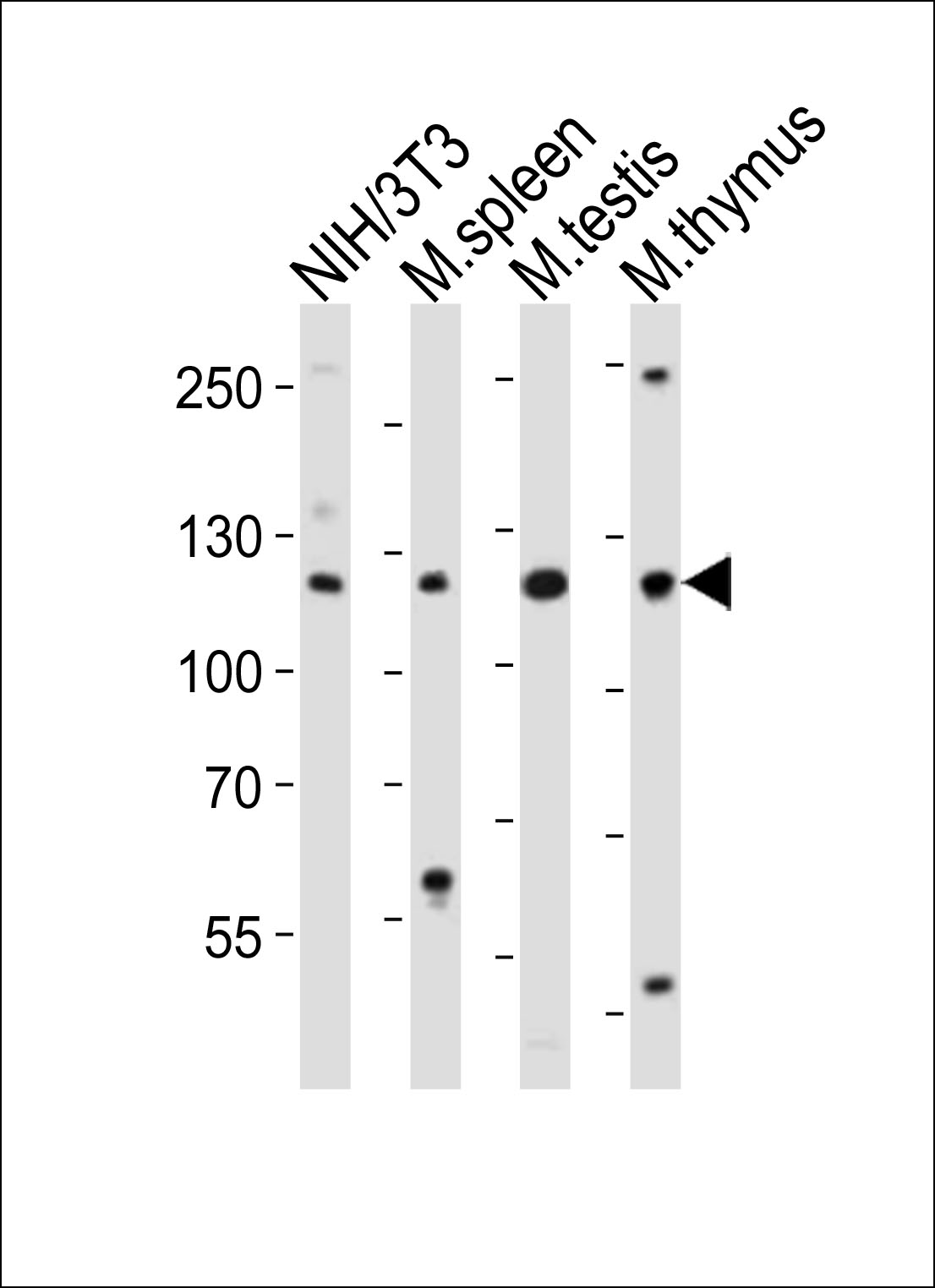(Mouse) Trim24 Antibody (C-term)
Purified Rabbit Polyclonal Antibody (Pab)
- SPECIFICATION
- CITATIONS
- PROTOCOLS
- BACKGROUND

Application
| WB, IF, IHC-P, E |
|---|---|
| Primary Accession | Q64127 |
| Reactivity | Mouse |
| Host | Rabbit |
| Clonality | Polyclonal |
| Isotype | Rabbit IgG |
| Calculated MW | 116657 Da |
| Gene ID | 21848 |
|---|---|
| Other Names | Transcription intermediary factor 1-alpha, TIF1-alpha, 632-, E3 ubiquitin-protein ligase Trim24, Tripartite motif-containing protein 24, Trim24, Tif1, Tif1a |
| Target/Specificity | This Mouse Trim24 antibody is generated from a rabbit immunized with a KLH conjugated synthetic peptide between 789-843 amino acids from the C-terminal region of Mouse Trim24. |
| Dilution | IF~~1:25 WB~~1:2000 IHC-P~~1:25 |
| Format | Purified polyclonal antibody supplied in PBS with 0.09% (W/V) sodium azide. This antibody is purified through a protein A column, followed by peptide affinity purification. |
| Storage | Maintain refrigerated at 2-8°C for up to 2 weeks. For long term storage store at -20°C in small aliquots to prevent freeze-thaw cycles. |
| Precautions | (Mouse) Trim24 Antibody (C-term) is for research use only and not for use in diagnostic or therapeutic procedures. |
| Name | Trim24 |
|---|---|
| Synonyms | Tif1, Tif1a |
| Function | Transcriptional coactivator that interacts with numerous nuclear receptors and coactivators and modulates the transcription of target genes. Interacts with chromatin depending on histone H3 modifications, having the highest affinity for histone H3 that is both unmodified at 'Lys-4' (H3K4me0) and acetylated at 'Lys-23' (H3K23ac) (By similarity). Has E3 protein-ubiquitin ligase activity. Promotes ubiquitination and proteasomal degradation of p53/TP53. Plays a role in the regulation of cell proliferation and apoptosis via its effects on p53/TP53 levels. Up-regulates ligand-dependent transcription activation by AR, GCR/NR3C1, thyroid hormone receptor (TR) and ESR1. Modulates transcription activation by retinoic acid (RA) receptors, such as RARA. Plays a role in regulating retinoic acid-dependent proliferation of hepatocytes. Required for normal transition from proliferating neonatal hepatocytes to quiescent adult hepatocytes. |
| Cellular Location | Nucleus. Cytoplasm. Note=Detected in the cytoplasm of the zygote (PubMed:16880268). Translocates into the pronucleus at the time of genome activation (PubMed:16880268). Colocalizes with sites of active transcription (PubMed:10610177). Localizes to sites of DNA damage (By similarity). {ECO:0000250|UniProtKB:O15164, ECO:0000269|PubMed:10610177, ECO:0000269|PubMed:16880268} |
| Tissue Location | Detected in embryonic and adult liver. Detected in zygote and throughout embryogenesis (at protein level). Detected in all adult tissues, with the highest expression level in testis |

Thousands of laboratories across the world have published research that depended on the performance of antibodies from Abcepta to advance their research. Check out links to articles that cite our products in major peer-reviewed journals, organized by research category.
info@abcepta.com, and receive a free "I Love Antibodies" mug.
Provided below are standard protocols that you may find useful for product applications.
Background
Transcriptional coactivator that interacts with numerous nuclear receptors and coactivators and modulates the transcription of target genes. Interacts with chromatin depending on histone H3 modifications, having the highest affinity for histone H3 that is both unmodified at 'Lys-4' (H3K4me0) and acetylated at 'Lys-23' (H3K23ac) (By similarity). Has E3 protein-ubiquitin ligase activity. Promotes ubiquitination and proteasomal degradation of p53/TP53. Plays a role in the regulation of cell proliferation and apoptosis via its effects on p53/TP53 levels. Up-regulates ligand- dependent transcription activation by AR, GCR/NR3C1, thyroid hormone receptor (TR) and ESR1. Modulates transcription activation by retinoic acid (RA) receptors, such as RARA. Plays a role in regulating retinoic acid-dependent proliferation of hepatocytes. Required for normal transition from proliferating neonatal hepatocytes to quiescent adult hepatocytes.
References
le Douarin B.,et al.EMBO J. 14:2020-2033(1995).
le Douarin B.,et al.EMBO J. 15:6701-6715(1996).
Zhong S.,et al.Nat. Genet. 23:287-295(1999).
Seeler J.-S.,et al.Mol. Cell. Biol. 21:3314-3324(2001).
Torres-Padilla M.E.,et al.J. Cell Biol. 174:329-338(2006).
If you have used an Abcepta product and would like to share how it has performed, please click on the "Submit Review" button and provide the requested information. Our staff will examine and post your review and contact you if needed.
If you have any additional inquiries please email technical services at tech@abcepta.com.













 Foundational characteristics of cancer include proliferation, angiogenesis, migration, evasion of apoptosis, and cellular immortality. Find key markers for these cellular processes and antibodies to detect them.
Foundational characteristics of cancer include proliferation, angiogenesis, migration, evasion of apoptosis, and cellular immortality. Find key markers for these cellular processes and antibodies to detect them. The SUMOplot™ Analysis Program predicts and scores sumoylation sites in your protein. SUMOylation is a post-translational modification involved in various cellular processes, such as nuclear-cytosolic transport, transcriptional regulation, apoptosis, protein stability, response to stress, and progression through the cell cycle.
The SUMOplot™ Analysis Program predicts and scores sumoylation sites in your protein. SUMOylation is a post-translational modification involved in various cellular processes, such as nuclear-cytosolic transport, transcriptional regulation, apoptosis, protein stability, response to stress, and progression through the cell cycle. The Autophagy Receptor Motif Plotter predicts and scores autophagy receptor binding sites in your protein. Identifying proteins connected to this pathway is critical to understanding the role of autophagy in physiological as well as pathological processes such as development, differentiation, neurodegenerative diseases, stress, infection, and cancer.
The Autophagy Receptor Motif Plotter predicts and scores autophagy receptor binding sites in your protein. Identifying proteins connected to this pathway is critical to understanding the role of autophagy in physiological as well as pathological processes such as development, differentiation, neurodegenerative diseases, stress, infection, and cancer.





